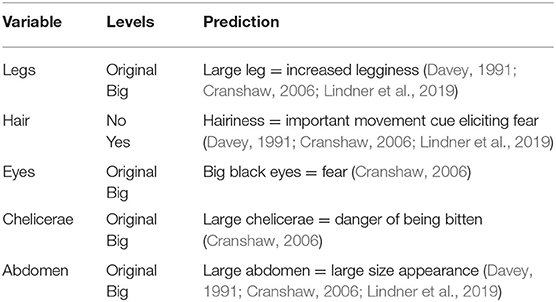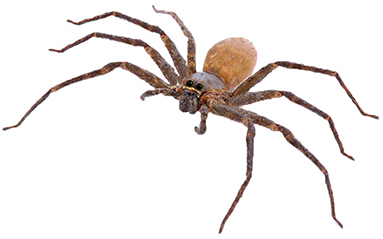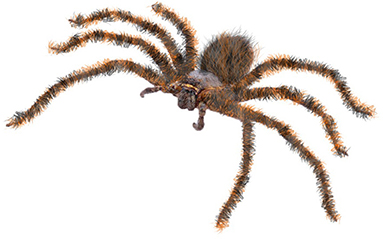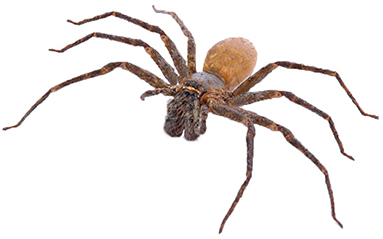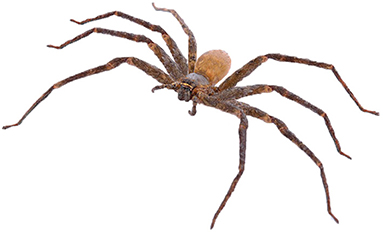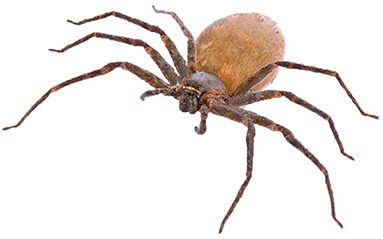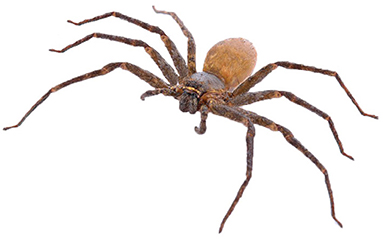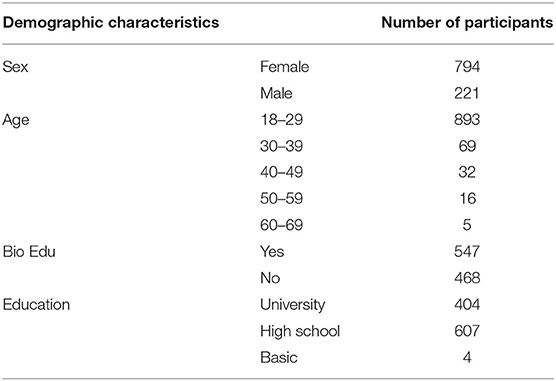What Makes Spiders Frightening and Disgusting to People?
- 1Department of Environmental Ecology and Landscape Management, Faculty of Natural Sciences, Comenius University, Bratislava, Slovakia
- 2Institute of Zoology, Slovak Academy of Sciences, Bratislava, Slovakia
- 3Department of Nuclear Physics and Biophysics, Faculty of Mathematics, Physics and Informatics, Comenius University, Bratislava, Slovakia
- 4Teacher Education Department, College of Education, University of Texas at El Paso, El Paso, TX, United States
The quality of human-animal interactions may crucially influence conservation efforts. Unfortunately, and despite their important roles in the functioning of the ecosystem, some animals are considered notoriously unpopular. Using the forced-choice paradigm, we investigated which cues humans perceive as frightening and disgusting in spiders, one of the most unpleasant animals in the world. The research was carried out with a representative sample of N = 1,015 Slovak adults. We found that perceived fear and disgust of spiders were triggered predominantly by enlarged chelicerae, enlarged abdomen, and the presence of body hair. Longer legs were associated with perceived fear as well; however, the presence of two eyes did not produce any statistical significance in terms of fear. We hope that further research in this field, where additional cues can be manipulated (e.g., color and number of legs), will improve conservation efforts by using an improved reputation of spiders in the eyes of the general public.
Introduction
Spiders are one of the most abundant and diverse orders of arthropods with nearly 50,000 known species (World Spider Catalog, 2021). As for other hyperdiverse groups, the conservation status of 99.5% of the species has not been assessed by the International Union for the Conservation of Nature (IUCN) (Seppälä et al., 2018; Milano et al., 2021). Data from few assessed species show, however, that habitat loss, urbanization, invasive species, pet trade, climate change, pollution, intense farming, and global insect abundance decline are major causes for the alarming loss of spiders species worldwide (Branco and Cardoso, 2020; Nyffeler and Bonte, 2020).
Although spiders play a key role in food webs ecosystem by regulating the density of other invertebrate herbivores and predators (Wise, 1995), their popularity with humans is low (e.g., Kellert, 1993; Davey, 1994a; Borgi and Cirulli, 2015; Prokop and Randler, 2018; Stanková et al., 2021). Furthermore, the prevalence of spider phobia (extreme innate fear of spiders) varies cross-culturally between 2.7 and 9.75% (Fredrikson et al., 1996; Oosterink et al., 2009; Zsido, 2017; Zsido et al., 2018; Polák et al., 2020a); it is considered as one of the most common animal phobias, particularly in women (Fredrikson et al., 1996). Spiders increase perceptual and attention processes in humans (Vuilleumier, 2005; Van Strien et al., 2009; New and German, 2015) from childhood (Prokop and Tunnicliffe, 2008; Rakison, 2009; LoBue, 2010). These processes do not seem to be generalized responses to small arthropods, since spiders are perceived as being more dangerous and disgusting than beetles, wasps, and butterflies (Gerdes et al., 2009).
Some researchers suggest that the fear of spiders can be explained in terms of biological preparedness (Seligman, 1971). More efficient search for threat-relevant objects, such as fears of spiders (Öhman et al., 2001; LoBue and DeLoache, 2008; LoBue, 2010), suggests that our ancestors responded quickly to dangerous animals, which ultimately enhanced their fitness (Penkunas and Coss, 2013; New and German, 2015); however, this explanation is problematic, because, unlike snakes, only a few species of spiders are dangerous to humans (Foelix, 1996). Some studies suggest that spiders are associated with attitudes of disgust and with survival strategies practiced in the Middle Ages. For instance, avoiding unclean, disgusting, and potentially contaminated places where spiders often occur (Davey, 1994b). Although some evidence suggests that Davey's hypothesis is incorrect, European descendants do not appear to be more afraid of spiders than people from areas that did not have a plague pandemic during the Middle Ages (Prokop et al., 2010a). Brain activity measured by using the early posterior negativity (EPN) turned out to be larger for snake pictures compared with spider pictures, which suggests that early attention to spiders is lower than attention to snakes (Van Strien et al., 2014a,b). Finally, fast detection and rapid learning in non-human primates are limited to snakes, but no similar evidence has been found for spiders (Kawai and Koda, 2016). These arguments seem to indicate that fear of spiders in human may have different roots than fear of snakes.
Because the evolutionary origin of fear of spiders in humans is still unclear, further research is needed to understand the main reasons as to why spiders are frightening and disgusting animals to most people (e.g., Polák et al., 2020a,b). In this study, we used a representative sample of Slovak people to examine which specific cues make spiders unpopular animals. We submit that this approach can contribute to an improvement in human-spider interactions. Conservation initiatives may improve their communication with the general public by avoiding cues, which were considered frightening or disgusting by people. Human emotions toward animals greatly influence their willingness to protect them (Prokop and Fančovičová, 2013a; Castillo-Huitrón et al., 2020); thus, research focused on public perception of undesired animals, such as spiders, is necessary. Perhaps, attention captured by spiders can be used for effective management in biodiversity conservation better than originally thought. Furthermore, identifying specific morphological cues of spiders that are frightening or disgusting may help us better understand the evolutionary origin of human fear/disgust of spiders. Previous research in this field was based on the analysis of responses of participants to open-ended questions (Cranshaw, 2006), or scaled items (Davey, 1991; Lindner et al., 2019). A review of the literature, in this field, reveals the absence of studies using experimental manipulation of cues in spider morphology to examine the effect of specific cues in the perception of this animal species as frightening or disgusting.
Methods
Participants and Procedure
This study was implemented online during the spring semester of 2021. Participants in the study consisted of N = 1,015 Slovak citizens with ages ranging between 18 and 69 years; they were recruited by the authors via online networks (Google Forms, Facebook) and through private e-mails; the research study was also advertised on the university web page. In all cases, and prior to assent to participate, each individual was informed that the focus of the research study was on the traits that humans find disgusting and dangerous in spiders. They were also informed that their participation, which entailed the completion of a short survey, was unpaid and voluntary. Previous experiences of authors suggest that time-spending questionnaires greatly discourage people to fill online questionnaires; thus, the most important questions were only included to obtain a representative sample sizes. The participants were presented with 15 pairs of spider images that had some body traits manipulated (only one image was modified to create the 15 pictures); they were asked to choose one image from each pair that in their views was perceived as disgusting. The same images were presented randomly a second time, the task was to choose images that were perceived as frightening. We used these two emotions because both are designed to protect an individual differently: disgust protects against pathogen contamination (e.g., Curtis et al., 2004), while fear prepares the body for fight-or-fly response (Gray, 1987). Furthermore, spiders elicit both disgust and fear (e.g., Gerdes et al., 2009; Polák et al., 2020b) and these emotions are important in the willingness to protect animals (Prokop et al., 2013; Castillo-Huitrón et al., 2020). The original picture met the following criteria: it conveyed the general spider pattern and included traits that could be easily manipulated to produce a poll of pictures instead of presenting participants with particular species of spiders.
Stimuli
According to the relevant literature (Davey, 1991; Cranshaw, 2006; Lindner et al., 2019), we modified several parts of the spider body, legs, eyes, hair, chelicerae, and abdomen (Table 1, Figures 1–6).
The original image (4620 × 2968 px | 39.1 cm × 25.1 cm | 300 dpi | JPG) has been purchased from “123RF.com” and processed in the Photoshop software (CS5 Version 12.0). The final images were obtained by manipulating body parts in the original image, the altered images were intended to emphasize the desired body characteristic (legs, eyes, chelicerae, abdomen, and hairs). The poll of spider pictures includes one original and five modified images, which were paired in 15 possible dyads.
Statistical Analyses
Analyses were conducted in R 4.0.4 (R Core Team, 2021). Discrete choice experiment (DCE) model estimates were used to predict the scariest and the most disgusting traits in a spider body. We used the DCE with unlabeled alternatives, a 15 choice set with two alternatives each, and described with five attributes. The DCE model was analyzed using conditional logit models in the R package “survival” (Therneau, 2021). The aesthetic characteristics (attributes) in Table 1 were used as predictor variables in multiple regression model. We added individual-specific variables (characteristics of decision-makers, gender, and academic background in biology/biology education). Since the alternatives are unlabeled, we used the interaction between alternative and individual-specific variables. All aesthetic characteristics were entered in the final logit models, but only statistically significant interactions were included. Hazard ratio (HR) is the ratio of chance of a picture with a modified particular trait to be chosen in place of an original image (or image without modified traits). When considering the particular trait, if HR <1 the probability for a picture with a modified trait to be chosen is lower than for the original picture and vice versa.
Results
Overall, 1,015 respondents with ages 18–69 years (794 females, 221 males) were included in the dataset. The demographical characteristics of the respondents are shown in Table 2.
Fear
When considering the answers from all participants, the scariest traits of a spider body were abdomen followed by chelicerae (Tables 3, 4). Indeed, spiders with enlarged abdomen or chelicerae were selected more often than the original image. In comparison with abdomen and chelicerae, hairiness was rated with lower fear scores. When comparing the responses of male and female participants, there was a difference in the perception of chelicerae. While for female respondents, the probability of choosing siders with large chelicerae was 2.97 (compared to the image without enlarged chelicerae), for male participants, the probability was 2.05. As stated before, respondents were also more likely to identify images with hairy spiders as scary than those without hair; however, female participants were more afraid of hairy spiders than males (the probability to be chosen is 2.11 in females and 1.49 in males). Enlarged eyes and legs were not statistically significant when evaluating fear. When looking at the responses from participants with a background in biology, the results indicate that these participants consider spiders with enlarged chelicerae to be more frightening as compared with those without training in biology. The reliability of the spider body characteristics according to the fear is shown in Figure 7.
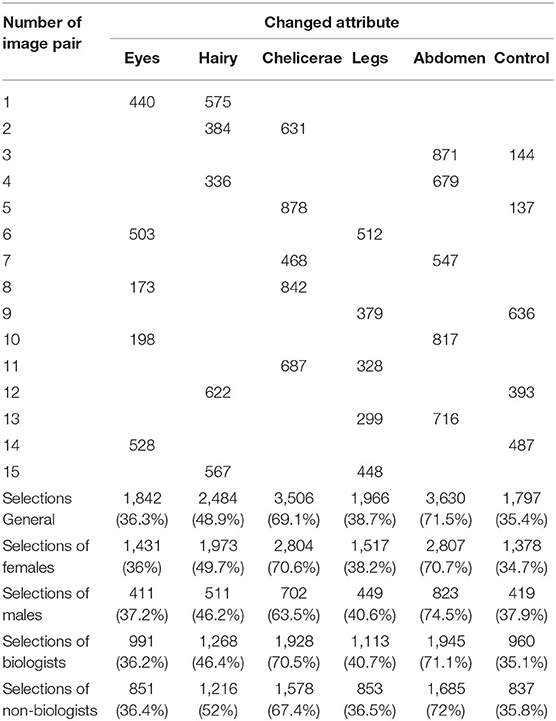
Table 3. A specific number of selections for each pair for each image in fear perception testing (general, gender, and biological education).
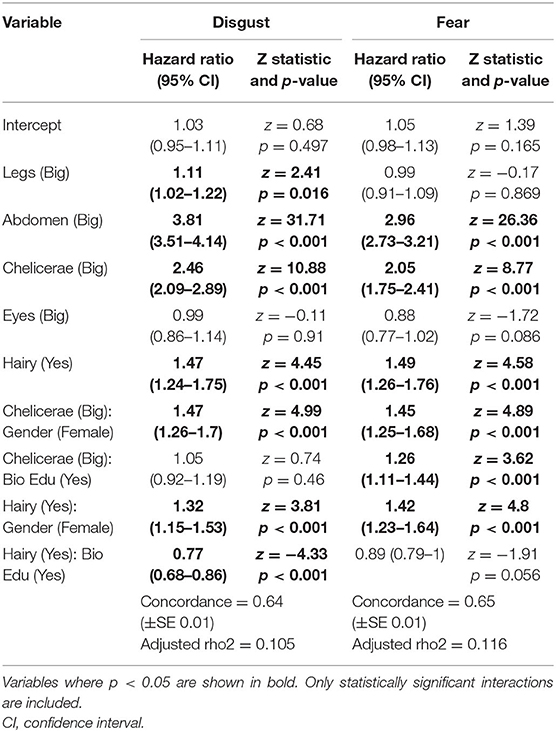
Table 4. Model estimates for multiple regressions of the mean degree of fear and disgust, where positive estimates suggest a variable increase in fear/disgust.
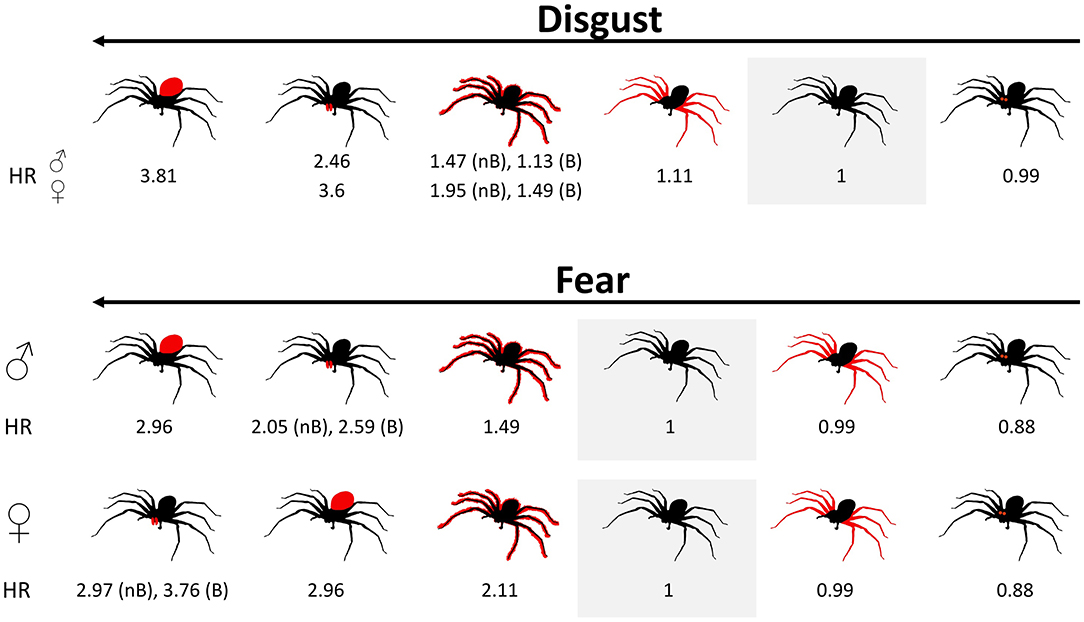
Figure 7. Reliability of spider body traits for disgust and fear perception. HR, hazard ratio; B, biologists; nB, non-biologists; gray square, control.
Disgust
In the exploration of the disgust factor against spider body traits, we found out that in general, the abdomen characteristic was rated as the most disgusting trait (Tables 4, 5). Spiders with enlarged chelicerae, hairy body, and spiders with enlarged legs were also considered disgusting in this order. The enlarged eye trait was not statistically significant for the disgust factor. When considering the gender of the participants, the perception of chelicerae as the second most disgusting trait was different. While female respondents chose enlarged chelicerae 3.6 times more often, the probability that males would choose the same trait was only 2.46. Hairy spiders were also considered to be more disgusting by the female (probability to be chosen is 1.95) than by male participants (probability decreased to 1.47). Interestingly, hairy spiders tended to be rated as less disgusting by respondents identified as biologists than by non-biologists. A diagram of the reliability of spider body traits for disgust perception is shown in Figure 1.
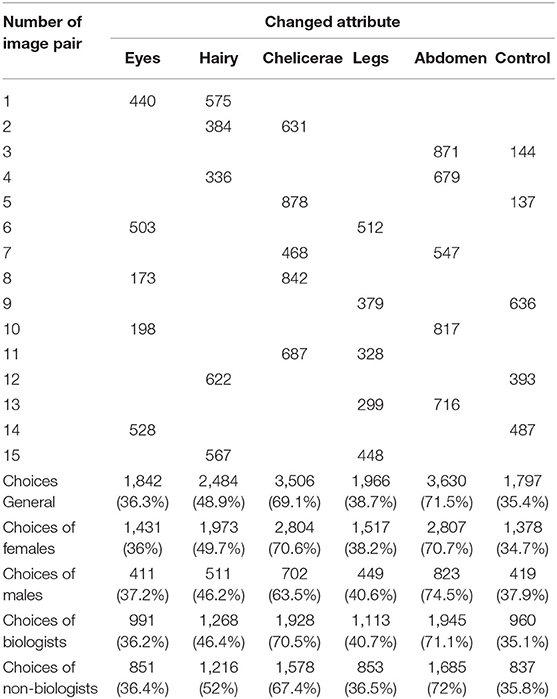
Table 5. Number of choices for each pair for each image in disgust perception testing (general, gender, and biological education).
Discussion
Cues triggering fear/disgust of spiders have long been a topic of interest to researchers in this field. Previous research has shown that “legginess,” spider movement, spider size, and hairiness (Davey, 1991; Lindner et al., 2019) or perceived danger (Cranshaw, 2006) are prominent cues associated with fear and disgust of spiders. In this article, we used a forced-choice paradigm and a representative non-clinical sample of participants to examine which of the visual stimuli elicits these two emotions. Although we did not investigate the effect of factors in the positive aesthetic domain, we studied the influence of negative values (Ceríaco, 2012) to determine what spider cues should be avoided in the conservation programs.
Chelicerae and abdomen were the scariest body traits in spider. Female participants perceived enlarged chelicerae as more frightening than their male counterparts. In contrast, and for both groups, the abdomen of the spider elicited more disgust, while enlarged chelicerae, hairiness, and enlarged legs also contributed to the perception of spiders as disgusting animals. Female respondents considered hairiness more disgusting than males.
Often, animal weapons that can potentially threaten humans come in the form of straight objects; thus, it is not surprising to find out that humans have an evolutionary predisposition to pay attention to potentially harmful objects, such as sharp teeth, claws, animal spikes, and horns (Wrangham and Peterson, 1996; Souchet and Aubret, 2016). This finding is in agreement with Cranshaw's (2006) study reporting on the views of students of bites and perceived danger as underlying factors related to fear of spiders. Interestingly, however, participants rarely cited chelicerae as an indication of fear in some of the previous studies (Davey, 1991; Lindner et al., 2019). This finding suggests that visual cues need to be considered in research on emotions elicited by spiders; a reason for this assumption is that certain subtle morphological characteristics could alter visual perception, but could be overlooked when responses are recorded solely by scaled items.
Enlarged abdomen significantly contributed to the rating of fear and disgust; however, this trait seemed to play a more prominent role in the perception of disgust than fear. We suggest that the abdomen of spider plays a dual role in perceived fear and disgust. An enlarged abdomen may visually enlarge the body of the spider, and the larger the size of an animal, the more likely it is perceived as a threat for humans (Prokop et al., 2010b; Stanková et al., 2021). This may be a simple mechanism as an enlarged abdomen can increase perceived fear. Enlarged abdomen, however, may also superficially resemble a big tick or other blood-eating ectoparasites that can transmit serious infections to humans (e.g., de la Fuente et al., 2008).
The presence of body hair seems to be significantly associated with both fear and disgust of spiders (Davey, 1991). We suggest that the rationale for this perception (fear of hairiness) is that body hair (or fur) when standing up in many mammals occur when the animal is threatened. The elevated body hair strategy makes the animal appear bigger than its original size (Bubenik and Bubenik, 1990). Body hair can be therefore perceived as a cue of fear. With respect to the emotion of disgust, body hair correlates with disgust sensitivity (Tiggemann and Lewis, 2004), perhaps because hairy bodies can suffer from high loads of ectoparasites that end up transferring diseases to the host animal, and ultimately decreasing the fitness of an individual (Rantala, 1999; Prokop et al., 2013). Thus, it is not surprising to find that their presence was also associated with disgust of spiders.
In general, women are more feared of spiders than men (e.g., Cornelius and Averill, 1983; Gerdes et al., 2009), and it is possible that certain gender differences, in this study, could be the result of greater fear among female participants. In particular, spider chelicerae were significantly more associated with the fear of spiders in females than in the male group. Furthermore, hairiness was also more associated with disgust by females than by male respondents. Regarding the former, female participants reported greater fear of predators than male participants (e.g., Røskaft et al., 2003; Prokop and Fančovičová, 2010, 2013b). Perhaps, female lower physical condition (Puts, 2010) and greater vulnerability to predation (Treves and Naughton-Treves, 1999) could be ultimately responsible for a greater fear of sharp spider chelicerae. Regarding the latter, females are more disgust sensitive than males (Curtis et al., 2004), and, therefore, hairy spiders were perceived as more disgusting for females than for males.
The long legs feature is thought to promote fear of spiders (Davey, 1991; Lindner et al., 2019), and results in this study partly support this idea; however, this trait is not a prominent factor in eliciting fear and disgust. We suggest that legginess should be investigated with manipulation of the total number of legs of spiders and with interactive videos, where spider movement can be observed along with modified legs in relation to their size or number before reaching any conclusion. Contrary to these findings, spider eyes did not show any significant influence on ratings of fear or disgust. We suggest that this null effect could be caused by insufficient manipulation (e.g., eyes could be bigger) or by the fact that eye contact in humans triggers altruism rather than aversive response (e.g., Bateson et al., 2006).
In this study, participants with a background in biology were less fearful of snakes and spiders than those without training in this discipline (Polák et al., 2016, 2020a). Compared with the non-biologists group, we found that biologist participants rated hairy spiders less frightening and less disgusting (although marginally not significant). Biologists are expected to be knowledgeable about animals, and their general interest in animals should be higher than in non-biologists.
The conservation of spiders seems to be more difficult than that of any other invertebrates (and most vertebrates), and this is partly due to the fact that at least in the Western culture, spiders are considered dangerous, small, and apparently insignificant (Branco and Cardoso, 2020). In addition, the absence of any economic benefits from investing in their protection makes spider conservation even more difficult. Understanding beliefs and preferences among the public may result in more successful pro-environmental actions (Alves et al., 2012). Compared with research on vertebrates, it seems that conservationists should avoid some universal features on animal bodies, such as large bodies, short legs, small eyes, and dull coloration (Frynta et al., 2019; Rádlová et al., 2019). In addition to these features, we found that long legs and excessive hairy bodies should be avoided when presenting a representative spider specimens to the public. Regarding body coloration, further research on spiders is required.
Citizen science and educational programs not only would increase awareness of animal species that can be easily identified species (Devictor et al., 2010) but also a powerful tool to address the negative perception of spiders (Wagler, 2017; Albo et al., 2019). We acknowledge that individuals by themselves are not in the best position to establish protected areas and manage the conservation of endangered species, however, we believe that everyone can avoid killing spiders in their households, and instead relocate them to different areas. Similarly, everyone could reduce the use of pesticides which are harmful not only for spiders but also for insects, a major food source of almost all known spider species. Finally, almost everyone can reduce mowing their lawns to support the biodiversity of insects and consequently spiders. We believe that more comprehensive investigations on the effect of cues as predictors of dangerous/disgusting perceptions can help in developing empathy for spiders. We consider this study as an initial step in this direction. Although we still do not know which cues are attractive, we have provided some evidence that unattractive (i.e., dangerous/disgusting) cues need to be considered and avoided in spider conservation programs.
Conclusion
Large chelicerae, abdomen, and hairy bodies are specific cues that promote fear and disgust of spiders. Each emotion is associated with slightly different cues, and female participants appear to be more sensitive to sharp, fear eliciting cues, such as chelicerae, as well as to disgust-eliciting cues, such as body hair, than their male counterparts. We consider that with this study, we have taken a further step toward understanding the bad reputation people assign to spiders. It seems that the use of manipulated visual cues produces different results than scores obtained by rated items. Visual cues, therefore, need to be considered in similar research in the future. We also submit that further research needs to consider additional visual cues that we did not manipulate (e.g., color), as well as videos, where spider movement and leg length and number will be experimentally treated. Finally, it would be helpful to determine whether individuals who are fearful of spiders perceive certain body parts as more frightening or disgusting than those in non-clinical samples. We hypothesize that careful identification of these cues can help improve conservation strategies by using more positive human-spider interactions.
Data Availability Statement
The raw data supporting the conclusions of this article will be made available by the authors, without undue reservation.
Ethics Statement
Ethical approval was not provided for this study on human participants because this study does not require ethical approval. The patients/participants provided their written informed consent to participate in this study.
Author Contributions
All authors listed have made a substantial, direct and intellectual contribution to the work, and approved it for publication.
Funding
This research was supported by Grant VEGA Nos. 1/0007/2021, 1/0286/2020, and APVV 20–0081.
Conflict of Interest
The authors declare that the research was conducted in the absence of any commercial or financial relationships that could be construed as a potential conflict of interest.
Acknowledgments
We are extremely grateful to Roman Dorič for his help with the manipulation of the spider images.
References
Albo, M. J., Montes De Oca, L., and Estevan, I. (2019). Fearless and positive children after hands-on educational experience with spiders in South America. J. Biol. Educ. doi: 10.1080/00219266.2019.1703783. [Epub ahead of print].
Alves, R. R. N., Vieira, K. S., Santana, G. G., Vieira, W. L. S., Almeida, W. O., Souto, W. M. S., et al. (2012). A review on human attitudes towards reptiles in Brazil. Environ. Monit. Assess. 184, 6877–6901. doi: 10.1007/s10661-011-2465-0
Bateson, M., Nettle, D., and Roberts, G. (2006). Cues of being watched enhance cooperation in a real-world setting. Biol. Lett. 2, 412–414. doi: 10.1098/rsbl.2006.0509
Borgi, M., and Cirulli, F. (2015). Attitudes toward animals among kindergarten children: species preferences. Anthrozoos 28, 45–59. doi: 10.2752/089279315X14129350721939
Branco, V. V., and Cardoso, P. (2020). An expert-based assessment of global threats and conservation measures for spiders. Global Ecol. Conserv. 24:e01290. doi: 10.1016/j.gecco.2020.e01290
Bubenik, G. A., and Bubenik, A. B., (eds.) (1990). Horns, Pronghorns, and Antlers: Evolution, Morphology, Physiology, and Social Significance. New York, NY: Springer Verlag.
Castillo-Huitrón, N. M., Naranjo, E. J., Santos-Fita, D., and Estrada-Lugo, E. (2020). The importance of human emotions for wildlife conservation. Front. Psychol. 11:1277. doi: 10.3389/fpsyg.2020.01277
Ceríaco, L. M. (2012). Human attitudes towards herpetofauna: the influence of folklore and negative values on the conservation of amphibians and reptiles in Portugal. J. Ethnobiol. Ethnomed. 8:8. doi: 10.1186/1746-4269-8-8
Cornelius, R. R., and Averill, J. R. (1983). Sex differences in fear of spiders. J. Pers. Soc. Psychol. 45, 377–383. doi: 10.1037/0022-3514.45.2.377
Cranshaw, W. (2006). Attitudes and concerns about spiders expressed in a freshman entomology class. Am. Entomol. 52, 234–238. doi: 10.1093/ae/52.4.234
Curtis, V., Aunger, R., and Rabie, T. (2004). Evidence that disgust evolved to protect from risk of disease. P. Roy. Soc. Lond. B Bio. 271, 131–133. doi: 10.1098/rsbl.2003.0144
Davey, G. C. (1991). Characteristics of individuals with fear of spiders. Anxiety Res. 4, 299–314. doi: 10.1080/08917779208248798
Davey, G. C. (1994a). Self-reported fears to common indigenous animals in an adult UK population: the role of disgust sensitivity. Br. J. Psychol. 85, 541–554. doi: 10.1111/j.2044-8295.1994.tb02540.x
Davey, G. C. L. (1994b). The “disgusting” spider: the role of disease and illness in the perpetuation of fear of spiders. Soc. Anim. 2, 17–25. doi: 10.1163/156853094X00045
de la Fuente, J., Estrada-Pena, A., Venzal, J. M., Kocan, K. M., and Sonenshine, D. E. (2008). Overview: ticks as vectors of pathogens that cause disease in humans and animals. Front. Biosci. 13, 6938–6946. doi: 10.2741/3200
Devictor, V., Whittaker, R. J., and Beltrame, C. (2010). Beyond scarcity: citizen science programmes as useful tools for conservation biogeography. Diversity Distribut. 16, 354–362. doi: 10.1111/j.1472-4642.2009.00615.x
Foelix, R. F. (1996). “Metabolism,” in Biology of Spiders, ed R. F. Foelix (New York, NY: Oxford University Press), 38–67.
Fredrikson, M., Annas, P., Fischer, H., and Wik, G. (1996). Gender and age differences in the prevalence of specific fears and phobias. Behav. Res. Ther. 34, 33–39. doi: 10.1016/0005-7967(95)00048-3
Frynta, D., Peléšková, Š., Rádlová, S., Janovcová, M., and Landová, E. (2019). Human evaluation of amphibian species: a comparison of disgust and beauty. Sci. Nat. 106, 1–19. doi: 10.1007/s00114-019-1635-8
Gerdes, A. B., Uhl, G., and Alpers, G. W. (2009). Spiders are special: fear and disgust evoked by pictures of arthropods. Evol. Hum. Behav. 30, 66–73. doi: 10.1016/j.evolhumbehav.2008.08.005
Gray, J. A. (1987). The Psychology of Fear and Stress, Vol. 5. New York, NY: Cambridge University Press.
Kawai, N., and Koda, H. (2016). Japanese monkeys (Macaca fuscata) quickly detect snakes but not spiders: evolutionary origins of fear-relevant animals. J. Comp. Psychol. 130, 299–303. doi: 10.1037/com0000032
Kellert, S. R. (1993). Values and perceptions of invertebrates. Conserv. Biol. 7, 845–855. doi: 10.1046/j.1523-1739.1993.740845.x
Lindner, P., Miloff, A., Reuterskiöld, L., Andersson, G., and Carlbring, P. (2019). What is so frightening about spiders? Self-rated and self-disclosed impact of different characteristics and associations with phobia symptoms. Scand. J. Psychol. 60, 1–6. doi: 10.1111/sjop.12508
LoBue, V. (2010). And along came a spider: an attentional bias for the detection of spiders in young children and adults. J. Exp. Child Psychol. 107, 59–66. doi: 10.1016/j.jecp.2010.04.005
LoBue, V., and DeLoache, J. S. (2008). Detecting the snake in the grass: attention to fear-relevant stimuli by adults and young children. Psychol. Sci. 19, 284–289. doi: 10.1111/j.1467-9280.2008.02081.x
Milano, F., Blick, T., Cardoso, P., Chatzaki, M., Fukushima, C. S., Gajdoš, P., et al. (2021). Spider conservation in Europe: a review. Biol. Conserv. 256:109020. doi: 10.1016/j.biocon.2021.109020
New, J. J., and German, T. C. (2015). Spiders at the cocktail party: an ancestral threat that surmounts inattentional blindness. Evol. Hum. Behav. 36, 165–173. doi: 10.1016/j.evolhumbehav.2014.08.004
Nyffeler, M., and Bonte, D. (2020). Where have all the spiders gone? Observations of a dramatic population density decline in the once very abundant garden spider, Araneus diadematus (Araneae: Araneidae), in the Swiss midland. Insects 11:248. doi: 10.3390/insects11040248
Öhman, A., Flykt, A., and Esteves, F. (2001). Emotion drives attention: detecting the snake in the grass. J. Exp. Psychol. Gen. 130, 466–478. doi: 10.1037/0096-3445.130.3.466
Oosterink, F. M. D., de Jongh, A., and Hoogstraten, J. (2009). Prevalence of dental fear and phobia relative to other fear and phobia subtypes. Eur. J. Oral. Sci. 117, 135–143. doi: 10.1111/j.1600-0722.2008.00602.x
Penkunas, M. J., and Coss, R. G. (2013). Rapid detection of visually provocative animals by preschool children and adults. J. Exp. Child Psychol. 114, 522–536. doi: 10.1016/j.jecp.2012.10.001
Polák, J., Rádlová, S., Janovcová, M., Flegr, J., Landová, E., and Frynta, D. (2020b). Scary and nasty beasts: self-reported fear and disgust of common phobic animals. Br. J. Psychol. 111, 297–321. doi: 10.1111/bjop.12409
Polák, J., Sedláčková, K., Landová, E., and Frynta, D. (2020a). Faster detection of snake and spider phobia: revisited. Heliyon 6:e03968. doi: 10.1016/j.heliyon.2020.e03968
Polák, J., Sedlackova, K., Nacar, D., Landova, E., and Frynta, D. (2016). Fear the serpent: a psychometric study of snake phobia. Psychiatr. Res. 242, 163–168. doi: 10.1016/j.psychres.2016.05.024
Prokop, P., and Fančovičová, J. (2010). Perceived body condition is associated with fear of a large carnivore predator in humans. Ann. Zool. Fenn. 47, 417–425. doi: 10.5735/086.047.0606
Prokop, P., and Fančovičová, J. (2013a). Does colour matter? The influence of animal warning coloration on human emotions and willingness to protect them. Anim. Conserv. 16, 458–466. doi: 10.1111/acv.12014
Prokop, P., and Fančovičová, J. (2013b). Self-protection versus disease avoidance: the perceived physical condition is associated with fear of predators in humans. J. Individ. Dif. 34, 15–23. doi: 10.1027/1614-0001/a000092
Prokop, P., and Randler, C. (2018). “Biological predispositions and individual differences in human attitudes toward animals,” in Ethnozoology, ed R. R. N. Alves (London: Academic Press), 447–466.
Prokop, P., Rantala, M. J., Usak, M., and Senay, I. (2013). Is a woman's preference for chest hair in men influenced by parasite threat? Arch. Sex. Behav. 42, 1181–1189. doi: 10.1007/s10508-012-0007-7
Prokop, P., Tolarovičová, A., Camerik, A. M., and Peterková, V. (2010a). High school students' attitudes towards spiders: a cross-cultural comparison. Int. J. Sci. Educ. 32, 1665–1688. doi: 10.1080/09500690903253908
Prokop, P., and Tunnicliffe, S. D. (2008). “Disgusting” animals: primary school children's attitudes and myths of bats and spiders. EURASIA J. Math. Sci. Tech. Ed. 4, 87–97. doi: 10.12973/ejmste/75309
Prokop, P., Usak, M., and Fančovičová, J. (2010b). Risk of parasite transmission influences perceived vulnerability to disease and perceived danger of disease-relevant animals. Behav. Process. 85, 52–57. doi: 10.1016/j.beproc.2010.06.006
Puts, D. A. (2010). Beauty and the beast: mechanisms of sexual selection in humans. Evol. Hum. Behav. 31, 157–175. doi: 10.1016/j.evolhumbehav.2010.02.005
R Core Team (2021). R: A Language and Environment for Statistical Computing. Vienna: R Foundation for Statistical Computing. Available online at: https://www.R-project.org/
Rádlová, S., Janovcová, M., Sedláčková, K., Polák, J., Nácar, D., Peléšková, Š., et al. (2019). Snakes represent emotionally salient stimuli that may evoke both fear and disgust. Front. Psychol. 10:1085. doi: 10.3389/fpsyg.2019.01085
Rakison, D. H. (2009). Does women's greater fear of snakes and spiders originate in infancy? Evol. Hum. Behav. 30, 438–444. doi: 10.1016/j.evolhumbehav.2009.06.002
Rantala, M. J. (1999). Human nakedness: adaptation against ectoparasites? Int. J. Parasitol. 29, 1987–1989.
Røskaft, E., Bjerke, T., Kaltenborn, B., Linnell, J. D., and Andersen, R. (2003). Patterns of self-reported fear towards large carnivores among the Norwegian public. Evol. Hum. Behav. 24, 184–198. doi: 10.1016/S1090-5138(03)00011-4
Seligman, M. E. P. (1971). Phobias and preparedness. Behav. Ther. 2, 307–320. doi: 10.1016/S0005-7894(71)80064-3
Seppälä, S., Henriques, S., Draney, M., Foord, S., Gibbons, A., Gomez, L., et al. (2018). Species conservation profiles of a random sample of world spiders I: agelenidae to Filistatidae. Biodivers. Data J. 6:e23555. doi: 10.3897/BDJ.6.e23555.suppl10
Souchet, J., and Aubret, F. (2016). Revisiting the fear of snakes in children: the role of aposematic signalling. Sci. Rep. 6:37619. doi: 10.1038/srep37619
Stanková, H., Janovcová, M., Peléšková, Š., Sedláčková, K., Landová, E., and Frynta, D. (2021). The ultimate list of the most frightening and disgusting animals: negative emotions elicited by animals in central european respondents. Animals 11:747. doi: 10.3390/ani11030747
Tiggemann, M., and Lewis, C. (2004). Attitudes toward women's body hair: relationship with disgust sensitivity. Psychol. Women Quart. 28, 381–387. doi: 10.1111/j.1471-6402.2004.00155.x
Treves, A., and Naughton-Treves, L. (1999). Risk and opportunity for humans coexisting with large carnivores. J. Hum. Evol. 36, 275–282. doi: 10.1006/jhev.1998.0268
Van Strien, J. W., Eijlers, R., Franken, I. H. A., and Huijding, J. (2014a). Snake pictures draw more early attention than spider pictures in non-phobic women: evidence from event-related brain potentials. Biol. Psychol. 96, 150–157. doi: 10.1016/j.biopsycho.2013.12.014
Van Strien, J. W., Franken, I. H., and Huijding, J. (2009). Phobic spider fear is associated with enhanced attentional capture by spider pictures: a rapid serial presentation event-related potential study. Neuroreport 20, 445–449. doi: 10.1097/WNR.0b013e3283262e26
Van Strien, J. W., Franken, I. H., and Huijding, J. (2014b). Testing the snake-detection hypothesis: larger early posterior negativity in humans to pictures of snakes than to pictures of other reptiles, spiders and slugs. Front. Hum. Neurosci. 8:691. doi: 10.3389/fnhum.2014.00691
Vuilleumier, P. (2005). How brains beware: neural mechanisms of emotional attention. Trends Cogn. Sci. 9, 585–594. doi: 10.1016/j.tics.2005.10.011
Wagler, R. (2017). The Amazing giant tree spiders of India and Sri Lanka! A community-based arachnid education and environmental education project. Int. Zoo Educ. Assoc. J. 23, 40–43
World Spider Catalog (2021). World Spider Catalog. Version 22.0. Natural History Museum Bern. Available online at: http://wsc.nmbe.ch (accessed April 12, 2021).
Wrangham, R. W., and Peterson, D. (1996). Demonic Males: Apes and the Origins of Human Violence. New York, NY: A Mariner Book/Houghton Mifflin Company.
Zsido, A. N. (2017). The spider and the snake – a psychometric study of two phobias and insights from the Hungarian validation. J. Psychiatr. Res. 257, 61–66. doi: 10.1016/j.psychres.2017.07.024
Keywords: attitudes toward animals, spiders, gender differences, human-animal relationship, morphology
Citation: Zvaríková M, Prokop P, Zvarík M, Ježová Z, Medina-Jerez W and Fedor P (2021) What Makes Spiders Frightening and Disgusting to People? Front. Ecol. Evol. 9:694569. doi: 10.3389/fevo.2021.694569
Received: 13 April 2021; Accepted: 07 June 2021;
Published: 14 July 2021.
Edited by:
Reuven Yosef, Ben-Gurion University of the Negev, IsraelReviewed by:
Jana Fančovičová, University of Trnava, SlovakiaMarkéta Janovcová, Charles University, Czechia
Copyright © 2021 Zvaríková, Prokop, Zvarík, Ježová, Medina-Jerez and Fedor. This is an open-access article distributed under the terms of the Creative Commons Attribution License (CC BY). The use, distribution or reproduction in other forums is permitted, provided the original author(s) and the copyright owner(s) are credited and that the original publication in this journal is cited, in accordance with accepted academic practice. No use, distribution or reproduction is permitted which does not comply with these terms.
*Correspondence: Pavol Prokop, pavol.prokop@savba.sk
 Martina Zvaríková1
Martina Zvaríková1  Pavol Prokop
Pavol Prokop Zuzana Ježová
Zuzana Ježová Peter Fedor
Peter Fedor